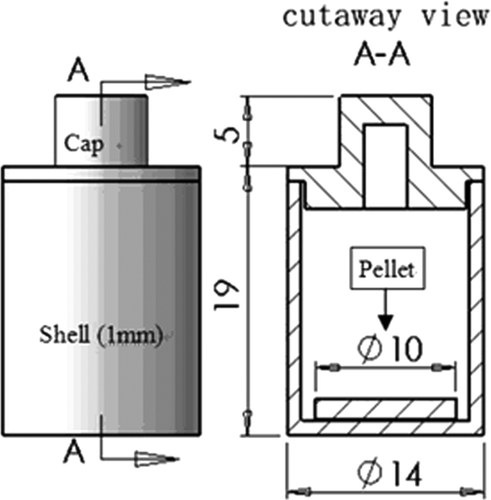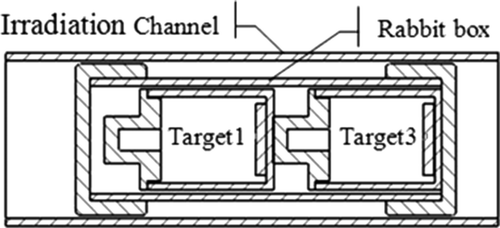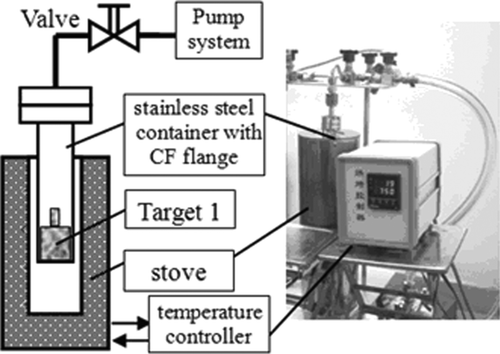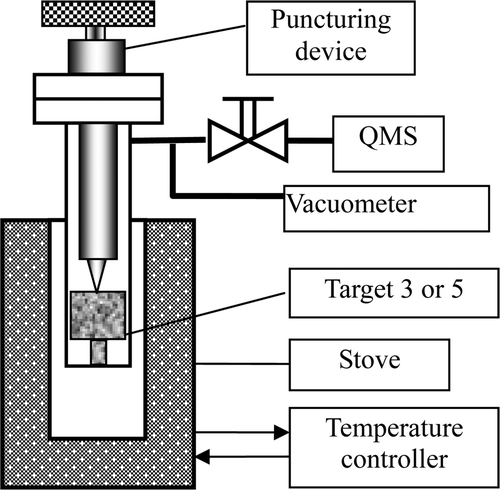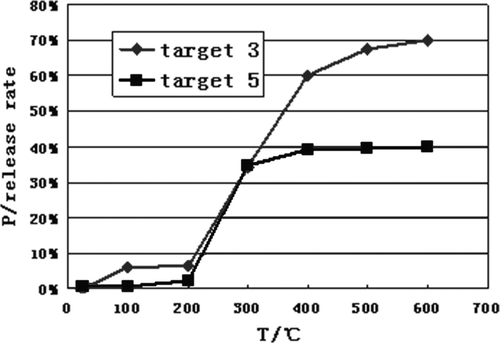Abstract
Xe-128 in I-127 transmutation targets irradiated by Xi'an pulse reactor was analyzed by using Quadrupole Mass Spectrometer (QMS) to calculate transmutation rate and release rate. Transmutation is an alternative method to transform long-lived toxic radio nuclides to short-lived radio nuclides or stable nuclides. 127I targets were irradiated in Xi'an Pulse Reactor for the first time to simulate the transmutation behavior of 129I. After irradiation, 128Xe in the target was determinate with online isotope dilution method by Quadrupole Mass Spectrometer (QMS), so that the transmutation rate and release rate could be calculated. Release behaviors of 128Xe were investigated through melting and step-heated modes. The stepwise heating experiment was done by puncturing method. The result shows the release rate in melting mode is 99.9% (RSD = 1%) and increases with the temperature in stepwise heating mode. The technique proposed in this work is suitable for accurate determination of transmutation rate of 129I.
1. Introduction
I-129 is a radiotoxic fission nuclide with a very long half life. Artificial transmutation of I-129 is therefore an alternative way to reduce radiotoxic risk [1–5]. I-127 is the stable iodine isotope of I-129 and has similar physical and chemical properties to I-129, and the transmutation product of I-127 is Xe-128. Many scientists have used I-127 instead of I-129 to perform relevant transmutation experiment, such as the investigation of the chemical form for irradiation in early researches [6–8]. In 1997, researchers from Netherland Energy Research Foundation ECN gave their long-time (192.95 days) transmutation results of I-127 irradiated by a high flux reactor (Petten). In their experiment, the xenon gas releasing from the powder target was measured to calculate transmutation rate by using puncturing method with mass spectrometer [6]. Because the powder iodide was used in their experiment and the target temperature had reached as high as 700 K, the release rate of xenon was not considered in the calculation. However, as the size of xenon atom is much smaller comparing to that of iodide powder, there might be lots of xenon atoms still staying in the iodide powder. In 2004, Japanese researchers and their Netherland co-workers have used I-127 to do another long-time (271.23 days) transmutation experiment in Petten [8]. In their experiment, the measurement method of transmutation rate was the same one used by ECN in 1997. But the iodide powder was compressed into small pallets this time. In their calculation, release rate of xenon in the pressed target was considered to be 100% at the sub-melting point. However, there were still many atoms of xenon which were not released from the compressed target bounded in iodide crystal. Besides, some researchers were interested in studying the transmutation rate by simulation code [9,10] and some experiments were done in short irradiation time, thus transmutation rate can be measured by γ spectrum [11–20]. But this measurement method is only suitable for short-time experiment and always has considerable uncertainty in the measurement of transmutation rates. However, xenon measurement method is suitable for both short-time and long-time transmutation experiments if only the amount of xenon reaches the lower detection limit of measuring device, QMS, for example. A main problem is that the release rate of Xenon must be accurately measured.
We have performed an experiment with three irradiated I-127 targets. For target 1, which is melted in a sealed container, the release rate of xenon is above 99.9%, and the uncertainty of the transmutation rate is determined to be 1%. At the same time, the release rates of xenon in the other two targets were measured with the puncturing method to investigate the dependence of the release rate on the temperature. The experiment results indicate that release rate should not be considered as 100% at the sub-melting point.
2. Experimental
In the experiment, the targets were irradiated in Xi'an Pulsed Reactor. A GAM400 QMS was used to analyze the released xenon. The relative quantitative uncertainty of 2.0 × 10−11 mol and 2.00 × 10−10 mol xenon is 3% and 1%, respectively.
2.1. Irradiation targets
Three targets in were sealed by 6061 Al alloy under vacuum condition and eligible in leakage check. The cores of target 1 and 3 were made from MgI2 powder and contained two pellets, respectively. The core of target 5 was made from MgI2 and Al powder and contained six pellets. As shown in (unit: mm), at the pressure of 400 MPa, each pellet in all targets has a diameter of ø 10 mm and a thickness ranging from 1 to 3 mm. And the granule diameter of MgI2 and Al powder was about 50 μm. The reason for choosing MgI2 and Al is that the productions of (n, γ) reactions of Mg-24 and Al-27 are stable Mg-25 and short lived Al-28, respectively, so the xenon-128 can be measured after short cooling time with low irradiation dose, and the two kinds of powder are easy to be mixed and shaped under high pressure. Targets 3 and 5 were used to investigate the release character of xenon after irritation.
To get accurate results, Xe-128 had to be generated be more than 2.00 × 10−10 mol. At the beginning, the mass of I-127 and irradiation time of the targets were coarsely evaluated according to the references [7] and [9]. lists the details of three targets in this experiment.
Table 1. Details of three targets.
2.2. Irradiation
All targets were irradiated in two rabbit channels of Xi'an Pulsed Reactor. As shown in , each channel can hold one rabbit box and each rabbit box can contain two targets. Rabbit box is made of nylon, and is operated automatically by a gas driving system. Target 1 and 3 are put in the first rabbit box in channel 1 and target 5 is in the second rabbit box in channel 2. Neutron flux in two channels are little different (2%): thermal neutron flux is about 1.4 × 1013 n/(cm2 · s) and other neutron flux is about 3.5 × 1011n/(cm2 · s). All targets were irradiated for 2 h. For the low neutron flux and short irradiation time, thermal behavior of all targets could be neglected in irradiation process.
2.3. Post-irradiation analysis
Target 1 was measured with melting method after 33 cooling days. As shown in , a stove has been designed to heat the target. The target 1, which was sealed in a stainless steel container with a set of CF flange, was put into the container in the stove and connected to a pumping system with a valve. The valve was opened until the container was pumped to 10 Pa, then it was closed and the temperature controller was set to 700°C for 1 h to melt the target so that Xe-128 was released completely. When the container was naturally cooled off to 21.5°C, it was demounted from the pump system and connected to the inlet system of QMS to measure the Xe-128. Xe-128 can be measured in the following steps:
| 1. | Sampling a part of gas into inlet system; | ||||
| 2. | Add dilution gas (Xe-129) on line to sampled gas; | ||||
| 3. | Purify the mixed gas to eliminate the most non-noble gases; | ||||
| 4. | Introduce the purified gas into ion source through a leaking hole with the diameter 10 μm; | ||||
| 5. | Measure the ratio of atoms of Xe-129 and Xe-128; | ||||
| 6. | Measure the melting container's volume to calculate the sample proportion factor; | ||||
Pb shielding has been designed in experiment, and is not shown in for simplicity.
In order to validate the release effect of xenon, after the measurement of xenon released in the first melting process, the remnant gas was pumped out, and the target 1 was melted for the second time. The released gas was measured again by QMS and the detail data are shown in .
Table 2. Results of all targets.
Target 3 and 5 were measured with puncturing method after 41 cooling days. A puncturing device has been designed to puncture 6061 aluminum of 2 mm in vacuum, as shown in . Target 3 or 5 was sealed in a self-made puncturing container connected to a vacuometer and QMS with a valve. The valve was opened until the container was pumped to 10 Pa, and then it was closed and the handle was screwed down for 5 mm. After 5 s, the handle was screwed back, and the pressure gauge was found to be at a high value soon, indicating that puncturing was successful. When the pressure value is steady, the valve is opened to sample the released gas into the inlet system of QMS to measure the Xe-128. Later, the valve was closed again and the temperature was set at 100°C, 200°C, 300°C, 400°C, 500°C, and 600°C, respectively, and the process was repeated. And a key step in each cycle was that the puncturing device must be cooled off to 21.5°C before the sample gas into the inlet system of QMS. The volume of puncturing device was measured to calculate total amount of Xe-128 every time after the target was heated. The Xe-128 release rates were calculated on the basis of results of six temperature points and the transmutation rate of target 1. The dependence of Xe-128 release rate on temperature is shown in .
3. Results
The measurement results are listed in . Data in column 3 of can be got from column 4 of , so the transmutation rate in column 7 of can be calculated according to the data in column 3 and 4 of . Because I-128 has a decaying probability of 94% to Xe-128 and 6% decaying probability to Te-128 [9], the calculation formula must be divided by 0.94. And the data in column 7 of was the last transmutation rate. For very similar target and irradiation conditions, target 3 or 5 is supposed to have the equivalent transmutation rate as target 1 and this value could be used to calculate the release rate of target 3 or 5 at different temperature. The calculation of release rate includes two steps: (1) The mass of Xe-128 in target 3 or 5 is calculated according to equivalent transmutation rate (column 7, ) and the quantity of I-127 (column 3, ). (2) The measured value of released Xe-128 at each temperature point is divided by the value calculated in step 1.
In the second melting process of target 1, Xe-128 is about 4 × 10−12 mol (row 3, column 4, ). Compared with the value (row 2, column 4, ) of the first melting process, the release rate is higher than 99.9%.
The mass of Xe-128 in target 3 at 21.5°C (row 4, column 4, ) is too little to be accurately measured with GAM400 QMS, so these data could not have an exact value but a scale to express a very low release rate.
The dependence of Xe-128 release rate on the temperature was also obtained, which is shown in . The release rate for target 3 remains little changed from 100°C to 200°C, but goes up fast after 200°C and change slowly after 400°C. The release rate for target 5 keeps steady from 21.5°C to 200°C, but goes up fast after 200°C and change slowly after 300°C. Neither is 100% at 600°C.
We have also compared some other transmutation rate measurement uncertainties with our result, as shown in . From data in column 5, we find that melting method can be obtained more little relative uncertainty of transmutation rate.
Table 3. Uncertainty comparison of melting method and other methods.
4. Discussions
Xenon gas in I-127 transmutation targets irradiated by Xi'an pulse reactor was analyzed by QMS. Two kinds of targets were irradiated and measured in this program. Transmutation rate of I-127 was successfully measured within 1% uncertainty by using melting method with QMS in our experiment. The release rates varying with temperatures of the two targets were got at several temperatures.
The release rate higher than 99.9% was got by melting method, and therefore can be assumed as 100% in transmutation rate calculation. This assumption would bring a relative uncertainty of 0.1% to the real transmutation rate. So the xenon measurement uncertainty is the main part. It is only 1% for 2.00 × 10−10 mol xenon by QMS. This is superior to other methods listed in .
Though the results show a very low release rate at 21.5°C with puncturing method, release rate for target 5 is evidently higher than that of target 3. Due to the difference in core material between target 3 (MgI2) and target 5 (mixture of MgI2 and Al), when the targets were compressed under 400 MPa, their structures are distinctly different. The target 3 has a fixed inner crystal structure while the target 5 has a looser one. This may be the main reason for the different release rate at 21.5°C. However, after being heated at a higher temperature, it is interesting to find that the release rate of target 3 is evidently higher than that of target 5. A probable reason is that MgI2 pellet disperses more easily than the mixed one in view of powder metallurgy. Though the reason is complex, both release rates are far from 100% at 600°C. The questions will be investigated in the next experiments.
For the very small cross section, (n, xn) reactions were not be considered in this experiment.
The radioactive leakage from the melting container was also concerned. Radioactive intensity of the CF flange () in whole heating procedure was measured with a radioactive dose gun, which proved the safety of the experiment and no contamination to inlet system of QMS.
Measurement technology in this experiment is also suitable for I-129 transmutation experiments. More experiment results will be reported after the next transmutation experiments.
References
- Wolkenhauer , W. C. , Leonard , B. R. Jr and Gore , B. F. 1772 . Transmutation of high-level radioactive waste with a controlled thermonuclear reactor , Battelle Pacific Northwest Laboratories Report BNWL- .
- Smith , C. F. and Cohen , J. J. 1980 . A critique of rationale for transmutation of nuclear waste , Brookhaven National Laboratory, Report BNL–28282 .
- Blomeke , J. O. and Croff , A. G. 1981 . Disposal of nuclear wastes by transmutation Available at http://www.osti.gov/energycitations/servlets/purl/6489361-C6jxwF/
- Attrep , M. J. 1992 . Accelerator transmutation of {sup 129I} , 92 – 64 . Los Alamos National Laboratory Report LA-UR– .
- Wootan , D. W. , Jordheim , D. P. and Matsumoto , W. Y. 1991 . Irradiation test of/sup 99Tc and/sup 129I transmutation in the Fast Flux Test Facility . Trans. Am. Nucl. Soc , 64 : 125 – 130 .
- Konings , R.J.M . 1997 . Transmutation of iodine: Results of the EFTTRA-T1 irradiation test . J. Nucl. Mater , 244 : 16 – 21 .
- Li , D , Imasaki , K , Horikawa , K , Miyamoto , S , Amano , S and Mochizuki , T . 2009 . Iodine transmutation through laser Compton scattering gamma rays . J. Nucl. Sci. Technol , 46 : 831 – 835 .
- Ichimura , E , Takaki , N , Schram , R.P.C , Meulekamp , R. K. and Bakker , K . 2004 . Iodine transmutation studies using metal iodide targets . J. Nucl. Mater , 334 : 149 – 158 .
- Hughes , H. G. and Engel , L. N. 1991 . Monte Carlo simulations of models for accelerator transmutation of waste , Los Alamos National Laboratory Report LA-UR–91–155 .
- Wilson , W. B. , Arthur , E. D. , Bowman , C. D. , Engel , L. N. , England , T. R. , Hughes , H. G. , Lisowski , P. W. and Perry , R. T. 1991 . Transmutation calculations for the accelerator transmutation of waste (ATW) program, Simulating accelerator radiation environments workshop” , 91 – 148 . Los Alamos National Laboratory Report LA-UR- .
- Krivopustov , M. I. , Pavliouk , A. V. , Kovalenko , A. D. , Brandt , R , Butsev , V. S. , Golubev , P. I. , Kalinnikov , V. G. , Karachuk , J , Kulakov , B. A. , Langrock , E. J. , Modolo , G , Ochs , M , Odoj , R , Premyshev , A. N. , Pronskich , V. S. , Schmidt , T , Stegailov , V. I. , Wan , J. S. and Zupko-Sitniko , V. M. 2009 . First results studying the transmutation of I-129, Np-237, Pu-238, and Pu-239 in the irradiation of an extended U-nat/Pb-assembly with 2.52 GeV deuterons . J. Radioanal. Nucl. Chem , 279 : 567 – 584 .
- Wan , J. S. and Brandt , R . 2001 . Studies on transmutation of long-lived nuclear waste Iodinein the accelerator-driven reactor . High Energy Phys. Nucl. Phys , 25 : 926 – 932 . (in Chinese)
- Wan , J. S. , Schmidt , T , Langrock , E. J. , Vater , P , Brandt , R , Adam , J , Bradnova , V , Bamblevski , V. P. , Gelovani , L , Gridnev , T. D. , Kalinnikov , V. G. , Krivopustov , M. I. , Kulakov , B. A. , Sosnin , A. N. , Perelygin , V. P. , Pronskikh , V. S. , Stegailov , V. I. , Tsoupko-Sitnikov , V. M. , Modolo , G , Odoj , R , Phlippen , P. W. , Zamani-Valassiadou , M , Adloff , J. C. , Debeauvais , M , Hashemi-Nezhad , S. R. , Guo , S. L. , Li , L , Wang , Y. L. , Dwivedi , K. K. , Zhuk , I. V. , Boulyga , S. F. , Lomonossova , E. M. , Kievitskaja , A. F. , Rakhno , I. L. , Chigrinov , S. E. and Wilson , W. B. 2001 . Transmutation of I-129 and (NP)-N-237 using spallation neutrons produced by 1.5, 3.7 and 7.4 GeV protons . Nucl. Instrum. Methods Phys. Res. Section A , 463 : 634 – 652 .
- Galkin , B.Ya , Isupov , V. K. , Kolyadin , A. B. , Kocherov , N. P. , Lyubtsev , R. I. , Nosov , A. A. and A.A . 2002 . Rimskii-Korsakov, Prospective large-scale transmutation of fission iodine . Radiochemistry , 44 : 144 – 147 .
- Henzl , V , Henzlova , D , Kugler , A , Wagner , V , Adam , J , Caloun , P , Kallnnikov , V. G. , Krivopustov , M. I. , Pavliouk , A. V. , Stegajlov , V. I. , Tsoupko-Sitnikov , V. M. and Westmeier , W . 2002 . Transmutation of 129I with high energy neutrons produced in spallation reactions induced by protons in massive target . J. Nucl. Sci. Technol , 2 : 1248 – 1251 .
- Westmeier , W , Brandt , R , Langrock , E. J. , Robotham , H , Siemon , K , Odoj , R , Adam , J , Bradnova , V , Golovatyuk , V. M. , Krasnov , V. A. , Krivopustov , M. I. , Pronskikh , V. S. , Sosnin , A. N. , Tsoupko-Sitnikov , V. M. , Vladimirova , N. M. , Hashemi-Nezhad , S. R. and Zamani-Valasiadou , M . 2005 . Transmutation experiments on I–129, La-139 and Np-237 using the Nuclotron accelerator . Radiochim. Acta , 93 : 65 – 73 .
- Adam , J , Balabekyan , A , Bradnova , V , Brandt , R , Golovatiouk , V. M. , Katovsky , K , Krivopustov , M. I. , Kalinnikov , V. G. , Odoj , R , Pronskikh , V. S. , Robotham , H , Siemon , K , Solnyshkin , A. A. , Stegailov , V. I. , Tsoupko-Sitnikov , V. M. , Vladimirova , N. M. and Westmeier , W . 2006 . Transmutation studies with GAMMA-2 setup using relativistic proton beams of the JINR Nuclotron . Nucl. Instrum. Methods Phys. Res. Section A , 562 : 741 – 742 .
- Adam , J , Pronskikh , V. S. , Tsoupko-Sitnikov , V. M. , Kalinnikov , V.G , Solnyshkin , A. A. , Stegailov , V. I. , Golovatiouk , V. M. , Vladimirova , N. M. , Krivopustov , M. I. , Babkin , V. A. , Kovalenko , A. D. , Westmeier , W , Robotham , H , Khilmanovich , A. M. , Martsynkevich , B. A. , Korbut , T. N. , Zhuk , I. V. , Potapenko , A. S. , Balabekyan , A. R. and Majerle , M . 2008 . Transmutation of 129I and 237Np in the secondary neutrons of graphite–lead setup exposed to deuterons with kinetic energy 2.33 GeV , 13 – 17 . 1st Workshop on accelerator radiation induced activation, Paul Scherrer Institut, Switzerland, October .
- M.I. Krivopustov, A.V. Pavliouk, A.D. Kovalenko, I.I. Mariin, A.F. Elishev, J. Adam, A. Kovalik, Yu. A. Batusov, V.G. Kalinnikov, V.B. Brudanin, P. Chaloun, V.M. Tsoupko-Sitnikov, A.A. Solnyshkin, V.I. Stegailov, Sh. Gerbish, O. Svoboda, Z. Dubnicka, M. Kala, M. Kloc, A. Krasa, A. Kugler, M. Majerle, V. Wagner, R. Brandt, W. Westmeier, H. Robotham, K. Siemon, M. Bielewicz, S. Kilim, M. Szuta, E. Strugalska-Gola, A. Wojeciechowski, S.R. Hashemi-Nezhad, M. Manolopoulou, M. Fragopolou, S. Stoulos, M. Zamani-Valasiadou, S. Jokic, K. Katovsky, O. Schastny, I.V. Zhuk, A.S. Potapenko, A.A. Safronova, Zh. A. Lukashevich, V.A. Voronko, V.V. Sotnikov, V.V. Sidorenko, W. Ensinger, H.D. Severin, S. Batsev, L. Kostov, Kh. Protokhristov, Ch. Stoyanov, O. Yordanov, P.K. Zhivkov, A.V. Kumar, M. Sharma, A.M. Khilmanovich, B.A. Marcinkevich, S.V. Korneev, Ts. Damdinsuren, Ts. Togoo, and H. Kumawat, First results studying the transmutation of I-129, Np-237, Pu-238, and Pu-239 in the irradiation of an extended U-nat/Pb-assembly with 2.52 GeV deuterons, Journal of Radioanalytical and Nuclear Chemistry, 279(2) (2009), pp. 567–584
- Adam , J , Katovsky , K , Balabekyan , A , Krivopustov , M. I. , Kumawat , H , Solnyshkin , A. A. , Stegailov , V. I. , Stetsenko , S. G. , Tsoupko-Sitnikov , V. M. and Westmeier , W . 2007 . Transmutation of I-129, Np-237 Pu-238, Pu-239, and Am-241 using neutrons produced in target-blanket system ‘Energy plus Transmutation’ by relativistic protons . Pramana–J. Phy , 68 : 201 – 212 .
